Bennemann K.H., Ketterson J.B. Superconductivity: Volume 1: Conventional and Unconventional Superconductors; Volume 2: Novel Superconductors
Подождите немного. Документ загружается.


1200 M. Lang and J. M¨uller
Aspin-fluctuationmediatedd-wave supercon-
ducting state has been found also by several other
approaches including FLEX, perturbation theory
or quantum Monte Carlo simulation applied to
-(ET)
2
X [315–318] or the quasi-one-dimensional
(TM)
2
X salts [317,319].In [320] and [319] an expla-
nation for the pseudogap behavior at elevated tem-
peratures T
∗
has been proposed in terms of strong
antiferromagnetic spin-fluctuations.
While the starting point of the above models is
in the limit of strong correlations,i.e. near the Mott-
insulating state, a somewhat different viewpoint is
taken in the work by Louati et al. [321]. These au-
thors studied the effect of spin fluctuations in a two-
dimensional model in the weak correlation regime
by varying the bandwidth and the nesting prop-
erties of the Fermi surface. They argued that spin
fluctuations are enhanced by the good nesting prop-
erties which may account for the anomalous NMR
relaxation rate observed at temperatures T
∗
above
T
c
in the -(ET)
2
Cu[N(CN)
2
]Br salt. Furthermore
they found that spin fluctuations can induce a su-
perconducting coupling with d-wave symmetry that
lies next to a spin-density-wave instability [321].
The above models address systems at half filling,
which is realized in the dimerized -phase (ET)
2
X
and (TMTSF)
2
X salts, suggesting spin-fluctuation-
mediated superconductivity with a d
x
2
−y
2
symme-
try. A different scenario has been proposed for the
and ˇ
structures [322]. Here the ET molecules
are not dimerized which results in a quarter-filled
hole band. In this case, a nearby insulating phase
is believed to be due to a charge ordering, driven
by strong inter-site Coulomb correlations.Applying
slave-boson theory to an extended Hubbard model
at quarter filling, superconductivity mediated by
charge fluctuations has been found. This results in a
d
xy
symmetry of the superconducting state [322] as
opposed to the d
x
2
−y
2
symmetry for the above spin-
fluctuation mechanism.
Experiments Probing the Superconducting State
On the experimental side, the determination of the
actual pairing mechanism is a most difficult task as
there is no decisive probe to pin down the relevant
pairing interaction. There are, however, some crucial
experiments which may help to delineate the various
possibilities.Investigatingthe mass-isotope effect on
T
c
is such a key experiment. Another one is to study
the phonon system to probe the role of electron–
phonon interactions. If phonons are involved in the
pairing interaction this would result in renormal-
ization effects in the temperature dependences of
the phonon frequencies and linewidths upon cooling
through T
c
. Likewise, if a non-phononic mechanism
is at work leading to an anisotropic gap with nodes
along certain directions on the Fermi surface, a de-
termination of the orientation of the gap zeroes by
angular-dependent measurements can provide im-
portant information on the pairing mechanism.
For classical phonon-mediated superconductors
the gap amplitude (k) is assumed to be isotropic
or at least to have an isotropic component combined
with a k-dependent part which obeys all symmetries
of the crystal lattice. In contrast to such a conven-
tional “finite-gap” state, the above mentioned elec-
tronic coupling schemes lead to a pairing state with
higher angular momentum where L =2(d-wave) be-
ing the most favored one.In this case the amplitude of
the Cooper-pair wave function vanishes at the origin
of the relative coordinatewhich keepsthe constituent
quasiparticles of the Cooper pair apart. Therefore,
L = 0 pairing states are good candidates for materi-
als with strong on-site Coulomb repulsion. The gap-
function of such an L =0statehasak-dependence
which is given by the spherical harmonics of the
same angular momentum. For those states where
the (k) functions vanish at certain k-vectors at the
Fermi surface, the quasiparticle excitation spectrum
at low energies is markedly different from that of
an isotropic finite gap state. For the above d-wave
order parameter (k)=
0
cos(k
x
a)−cos(k
y
b)
the
zero crossings along the diagonals correspond to line
nodes at the Fermi surface. This should be reflected
in all quantities that depend on the number of ther-
mally excited quasiparticles such as specific heat,
NMR relaxation rate, magnetic penetration depth,
etc. in the form of simple power-law dependences
at sufficiently low temperatures. In contrast, an ex-
ponentially weak T-dependence in these quantities
characterizes an isotropic non-vanishing order pa-

20 Organic Superconductors 1201
rameter. Thus, careful measurements of the above
thermal properties should, in principle, provide a
handle on the order-parameter symmetry, or at least
permit to discriminate whether gap zeroes exist or
not. In this context, it should be noted, however, that
the observation of a non-exponential or power-law
T-dependence in one of these quantities does not
necessarily imply a gap structure with nodes. As an
example, we mention gapless superconductivity via
pair breaking which destroys an exponential behav-
ior [323, 324]. Likewise, a power-law T-dependence
could be of conventional origin, as e.g. a T
3
de-
pendence in the specific heat for 0.2 T
c
< T < T
c
which has been attributed to strong-coupling effects
[325,326].
To our knowledge, the only example where a non-
phononic mechanism has been clearly identified is
the heavy-fermion superconductor UPd
2
Al
3
. Here,
the combination of tunnel spectroscopy [327] and
neutron scattering experiments [328] has provided
sound evidence for a magnetic pairing interaction,
i.e. the exchange of magnetic excitons.
Although numerous experiments have been de-
voted to the issue of the order parameter symme-
try for the organic materials, no consensus has yet
been achieved. It is fair to say that for the present
systems direct evidence for a non-phononic mech-
anism such as the one mentioned above does not
exist. Also phase-sensitive experiments as those ap-
plied successfully to the high-T
c
cuprates [329,330]
have not been performed so far for the organic ma-
terials.
In what follows we shall give a discussion of a se-
lection of experimental results on the pairing mech-
anism and the symmetry of the order parameter. To
begin with we shall focus on the (ET)
2
Xsalts.
Experiments on the Pairing Mechanism: Isotope Effect
and Electron–Phonon Coupling
The effect of isotope substitution has been studied
for various members of the (ET)
2
X superconductors.
Isotopes have been substituted in the ET molecule
by replacing
1
Hby
2
D in the ethylene endgroups,
by a partial exchange of
12
Cby
13
Cor
32
Sby
34
S
atoms in the inner skeleton of the molecule. In addi-
tion, systems have been studied where the acceptor
molecule has been isotopically labeled. First experi-
ments focused on the role of the electron-molecular-
vibration (EMV) coupling by substituting
13
C for
12
C
in the central double bond of the ET molecule. The
large decrease of T
c
of T
c
/T
c
=−2.5%foundfor
the high-temperature variant (ˇ
H
)ofˇ-(ET)
2
I
3
by
the Orsay group [331] could not be reproduced by
a subsequent study where no systematic decrease of
T
c
could be detected [332]. Most intensive studies
on the isotope effect have been carried out on the
-(ET)
2
Cu(NCS)
2
salt by the Argonne group [128].
Their investigationsinclude isotope substitutionson
both the BEDT-TTF molecules (all together seven
differently labeled BEDT-TTF derivatives) as well as
the anions.In each case, a batch of unlabeled samples
has been synthesized under strictly parallel experi-
mental conditions. These crystals serve as a refer-
ence for comparison. By sampling a large number
of crystals, typically eight or more of both labeled
and unlabeled material, a genuine mass-isotope ef-
fect on T
c
has been found: upon replacing all eight
sulfur atoms by
34
S and the outer-ring-carbonatoms
of the [(CH
2
)
2
]endgroupsby
13
C,which corresponds
to a 5 % increase of the ET molecule’s mass, a shift
of T
c
=−(0.12 ± 0.08) K has been observed. As-
suming a BCS-like mass-isotope effect T
c
∝ M
−˛
with the whole ET molecule as the relevant mass en-
tity M, this shift corresponds to ˛ =0.26 ± 0.11.
This experiment provides clear evidence that the in-
termolecular (lattice) phonon modes are strongly in-
volved in the pairing mechanism. On the other hand,
the same group demonstrated the absence of a com-
parableisotopeeffecton T
c
for-(ET)
2
Cu(NCS)
2
and
-(ET)
2
Cu[N(CN)
2
]Br upon a partial substitution of
the central C=C and also a simultaneous replace-
ment of both the central and ring C=C atoms. The
same holds true for a substitution of the eight sulfur
atoms,see [128]and referencestherein.These results
indicate that the intramolecular C=C and C–S bond-
stretching vibrational modes of the ET molecule do
not provide a substantial contribution to the Cooper
pairing.
Further indications for a strong electron–phonon
coupling have been inferred from measurements
of the thermal conductivity on -(ET)
2
Cu(NCS)
2
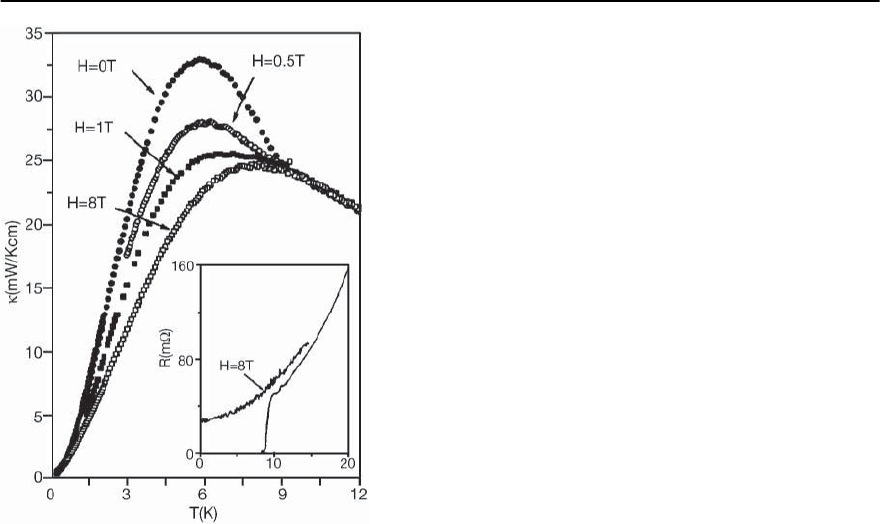
1202 M. Lang and J. M¨uller
Fig. 20.40. Temperature dependence of the thermal con-
ductivity of -(ET)
2
Cu(NCS)
2
for B applied perpendicular
to the planes. Inset: temperature dependence of the resis-
tance, taken from [60]
and -(ET)
2
Cu[N(CN)
2
]Br [50, 60, 61]. As shown
in Fig. 20.40, the thermal conductivity (T)of-
(ET)
2
Cu(NCS)
2
exhibits an upturn at the onset of
superconductivity followed by a pronounced max-
imum just below T
c
. It has been convincingly ar-
gued by the authors that the enhancement of (T)
in the superconducting state is a consequence of the
condensation of electrons into Cooper pairs which
strengthens the heat transport by freezing out the
scattering of the main heat carriers, the phonons.
By employing the Wiedemann–Franz law it has been
found that just above T
c
the electronic contribution
amounts to only 5% of the total thermal conductiv-
ity [60]. Figure 20.40 also shows (T) data taken at
varying fields applied perpendicular to the conduct-
ing planes.In the normal state,a magnetic field of 8 T
does not affect the thermal conductivity within the
resolution of the experiment but induces a sizeable
decrease in the charge conductivity (see inset) which
is an additional indication of lattice-dominated ther-
mal conductivity in the vicinity of T
c
.
Temperature-dependent Raman scattering stud-
ies of the phonon dynamics of -(ET)
2
Cu(NCS)
2
and -(ET)
2
Cu[N(CN)
2
]Br substantiate the strong
coupling of the superconducting charge carriers
to intermolecular phonons [54–59]. The observed
anomalous temperature dependence of the low-
frequency phonons around and below T
c
were found
to be consistent with an isotropic gap 2
0
close to
2.8 meV [58]. From the reported frequency shifts the
electron–phonon coupling constants
i
have been
calculated yielding a total coupling constant of
tot
=
0.97 ± 0.11 [58].
Superconductivity-InducedPhonon Renormalization
As a consequence of the interaction of charge car-
riers with the phonon system, the opening of a gap
in the electronic density of states below T
c
induces
changes in the phonon frequencies and linewidths.
These effects were first observed in the classical
superconductors Nb
3
Sn and Nb [333, 334]. The re-
sults of these studies support the generally accepted
picture that superconductivity in these materials is
phonon-mediated. Inelastic neutron-scattering ex-
periments have been performed on single crystals of
-(ET)
2
Cu(NCS)
2
on both hydrogenated and deuter-
ated crystals [62, 335]. Due to the extraordinarily
large incoherent cross section of the protons, the
study of -(H
8
-ET)
2
Cu(NCS)
2
allows for a selective
investigation of those vibrational modes that involve
the hydrogen atoms at the terminal ethylene groups.
The analysis of measurements above and below T
c
suggest a substantial coupling of these modes to the
superconducting charge carriers [335].Figure 20.41
shows the results of inelastic neutron-scattering ex-
periments on deuterated -(ET)
2
Cu(NCS)
2
carried
out by Pintschovius et al. [62]. The data reveal a sud-
den increase of the frequencies of transverse acous-
tic phonons upon cooling through T
c
. This phonon
hardening was found to be most pronounced for the
wave vector q =(−0.225, 0, 0.45) and a phonon en-
ergy 2.4 meV. As discussed by Zeyher and Zwick-
nagl [336], significant changes are expected only
for those phonons whose energy ! is close to
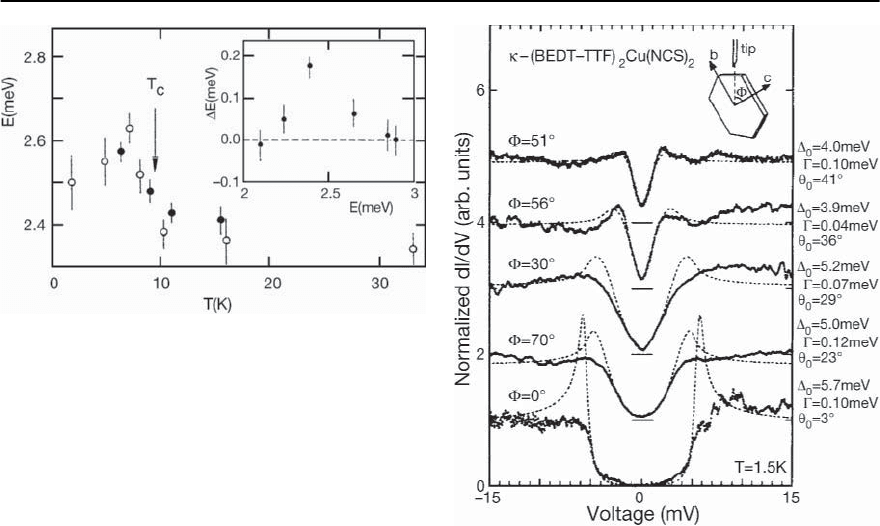
20 Organic Superconductors 1203
Fig. 20.41. Temperature dependence of the energy of
the transverse acoustic phonon with wave vector q =
(−0.225, 0, 0.45) derived from inelastic neutron scattering
on two different single crystals (open and closed circles)
of deuterated -(ET)
2
Cu(NCS)
2
.Inset: observed frequency
shifts [E = E(T < T
c
)−E(T > T
c
)] of transverse acoustic
phonons in the [−, 0, 2 ] direction,reproduced from [62]
the gap value 2 with a softening (hardening) for
! < 2 (! > 2 ) [336]. The above results thus
imply 2 2.4meV,i.e.2/k
B
T
c
3.1, which is
close to the BCS ratio of 3.52. The salient feature of
this study is that intermolecular modes strongly cou-
ple to the superconducting charge carriers and may
thus providea substantial contribution to thepairing
interaction [62].
On the Order-Parameter Symmetry in (BEDT-TTF)
2
X:
Measurements of the Gap Anisotropy
A new development in the investigation of the order-
parameter symmetry is to probe the gap anisotropy
directly by using orientational-dependent measure-
ments. For the present organic superconductors,
these techniques include mm-wave transmission
[337], STM spectroscopy [338] and thermal conduc-
tivity [61] studies.
An mm-wav e magneto-optical technique was used
to determine the angle dependence of the high-
frequency conductivity of -(ET)
2
Cu(NCS)
2
[337,
339]. The results have been interpreted to support
an anisotropic gap with “X shape”, i.e. with nodes
along the b-direction and c-direction [337], consis-
tent with a d
x
2
−y
2
symmetry of the order parameter
as theoretically suggested by Schmalian [310]. How-
Fig. 20.42. dI/dV-V curves taken at 1.5 K on the lateral sur-
faces of -(ET)
2
Cu(NCS)
2
single crystals. Data have been
taken along various tunneling directions at different an-
gles as defined in the inset.Thedashed line represents
the calculated curve based on the d-wave gap model with
a k dependent tunneling, taken from [338]
ever, these results have been critically commented
upon by other groups [340,341].
The superconducting gap structure of the same
compound has been investigated using STM spec-
troscopy by Arai et al. [338]. The tunneling curves
observed on the bc-plane (parallel to the conducting
layers) in the low-energy region could be well fitted
by a d-wavegapmodel.Thecorresponding2
0
/k
B
T
c
ratio was found to be 6.7 which is smaller than a pre-
viously reported value of 9 [342] but substantially
larger than the BCS value of 3.52.In addition,the in-
plane gap anisotropy was investigated,see Fig. 20.42.
The dI/dV-V curves observed on the lateral surfaces
were found to be also consistent with a d-wave gap.
For this configuration a very large 2
0
/k
B
T
c
ratio
of 8.7 ∼ 12.9 has been obtained. The analysis of the
angular dependence revealed that the direction of
the line nodes of the gap is /4fromthek
b
and k
c
-
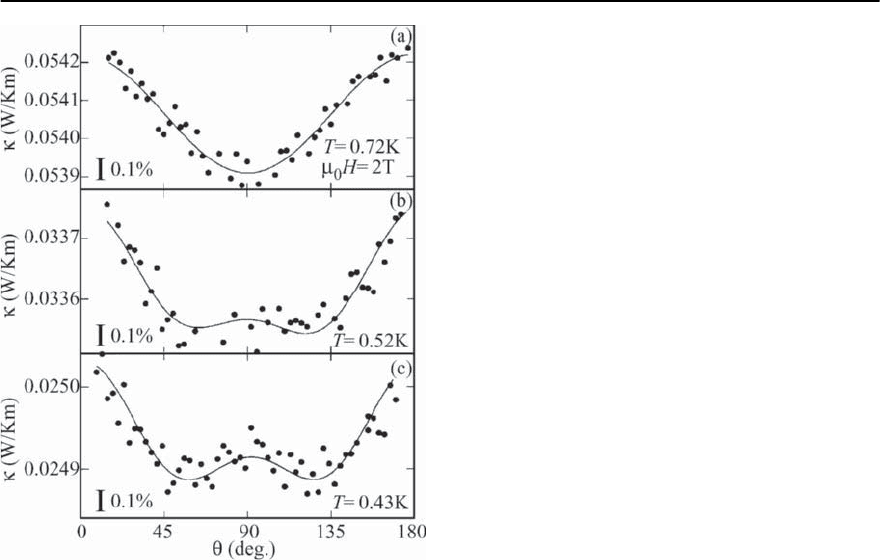
1204 M. Lang and J. M¨uller
Fig. 20.43. Angular variation of (B, Ÿ) at 2 T for differ-
ent temperatures where Ÿ denotes the angle between a
rotating magnetic field in respect to the heat current flow-
ing along the b-axis of the -(ET)
2
Cu(NCS)
2
crystal. The
solid lines represent the results of a fit using the function
(B, Ÿ)=C
0
+C
2Ÿ
cos 2Ÿ +C
4Ÿ
cos 4Ÿ,whereC
0
,C
2Ÿ
and
C
4Ÿ
are constants, taken from [61]
axes, i.e. the gap has d
x
2
−y
2
symmetry [338]. It has
been noted that these orientations of the gap nodes
are at variance with those inferred from the above
mm-wave-transmission experiments.
The thermal conductivity has been used as an-
other directional-dependent probe.When compared
to STM measurements,for example,this quantity has
the advantage that it is free of surface effects. The
implications of the symmetry of gap zeroes on the
thermal conductivity in the vortex state have been
theoretically investigated by various authors, see e.g.
Won and Maki [343]. Measurements have been per-
formed for the -(ET)
2
Cu(NCS)
2
salt in a magnetic
field rotating within the 2D superconducting plane.
Figure 20.43 shows the angular variation of at a
fixed field of B =2T.Ÿ denotes the angle between
the heat current flowing along the crystallographic b
direction and the magnetic field,i.e.Ÿ =0
◦
forB b .
The salient result of this study is the occurrence of a
() contribution with a fourfold symmetry,
4
,at
low temperatures T ≤ 0.52 K that adds to a predom-
inant term with twofold symmetry. While the latter
has been interpreted as being mainly phononic in
origin, it is argued that the former is of a purely
electronic nature and reflects the nodal gap struc-
ture [61]. Their analysis revealed that the gap zeroes
are oriented along the directions rotated by 45
◦
rela-
tive to the b and c-axes.It has been pointed out in [61]
that this nodal structure is inconsistent with the the-
ories based on antiferromagnetic spin fluctuation
where the nodes are expected to be along the b and
c-directions. Based on this observation Izawa et al.
proposed a d
xy
symmetry (referring to the magnetic
Brillouin zone, see inset of Fig. 1 in [61]) which has
been theoretically suggested for a charge-fluctuation
scenario [322,344].
NMR Measurements
A more indirect information on the symmetry of
the superconducting order parameter is provided by
temperature-dependent measurements of quantities
which depend on the quasiparticle excitation spec-
trum.InthiscontextNMRexperiments,i.e.measure-
ments of the Knight shift K
S
and the spin-lattice re-
laxation rate (T
1
)
−1
are of particular interest. The
13
C spin-lattice relaxation rate and Knight shift of -
(ET)
2
Cu[N(CN)
2
]Br have been investigated by var-
ious groups [143,257, 345] with similar results. In
these experiments single crystalline material was
used where both
12
C atomsin thecentral carbondou-
ble bondof the ET molecule had been replacedby
13
C.
For the investigation of electronic properties, these
nuclei are superior since their coupling to the -
electronsystemis much stronger than that of the pro-
tons in the ethylene endgroups of the ET molecules.
The salient results of these studies are: (i) Knight-
shift measurements performed in fields aligned par-
allel to the conducting planes reveal a spin suscepti-
bility thattendsto zero atlow temperatures.Sinceany
contributions from the pancake vortices have been
excluded for this field configuration, the above re-
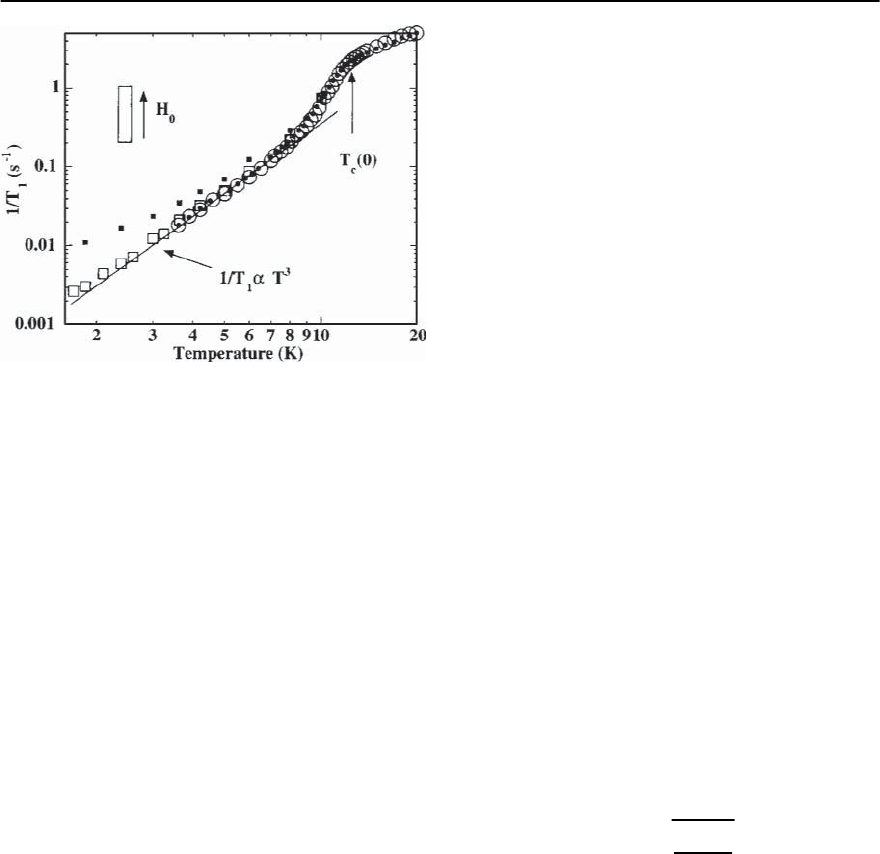
20 Organic Superconductors 1205
Fig. 20.44. Spin-lattice-relaxation rate (T
1
)
−1
at fields of
5.6 T (open circles), 7.8 T (black circles)and7T(open
squares) applied parallel to the conducting planes of -
(ET)
2
Cu[N(CN)
2
]Br. Black squa res correspond to a field of
7 T with a small misalignment, taken from [257]
sults have been taken as evidence for the spin-singlet
character of the pairing state. (ii) The spin-lattice re-
laxation rate, (T
1
)
−1
, measured in the same parallel
field configuration lacks a Hebel–Slichter peak and
shows a power-law T
n
behavior at low T,withn be-
ing close to 3, see Fig. 20.44. For the experimental
conditions chosen, the authors ascribed the domi-
nant source of relaxation to the quasiparticle exci-
tations in the superconducting state. Consequently,
the power-law temperature dependence in (T
1
)
−1
has
been interpreted as indicating an anisotropicpairing
with nodes in the gap function [143,257,345].
Thermal Conductivity
Investigations of the thermal conductivity on quasi-
2D organic superconductors at low temperatures
have been performed first on -(ET)
2
Cu(NCS)
2
[60]
and more recently also on -(ET)
2
Cu[N(CN)
2
]Br
[50]. These studies reveal that the onset of supercon-
ductivity is associatedwitha suddenincrease of (T)
which can be suppressed by a moderate magnetic
field.The enhancement of (T)attheonsetofsuper-
conductivity has been attributed to a strengthening
of the phonon heat transport by reducing the scatter-
ing dueto the gap formation.Their argumentis based
on a quantitative analysis of the data employing the
Wiedemann–Franz law. It showed that just above T
c
the electronic contribution amounts to only 5 % of
the total thermal conductivity. A lattice-dominated
thermal conductivity around T
c
is also consistent
with the absence of a magnetic field dependence of
in this temperature range [60].As for the question of
the gap symmetry, the data at low temperature have
been interpreted as indicating an excitation spec-
trum with gap zeroes: an extrapolation of the data
for -(ET)
2
Cu(NCS)
2
to T → 0 revealed a finite in-T
linear term which has been attributed to a residual
electronic contribution [60]. The latter is expected
for an unconventional superconductor due to impu-
rity scattering of residual quasiparticles [346,347].
On the other hand, recent thermal conductiv-
ity measurements on the -(ET)
2
Cu[N(CN)
2
]Br salt
showed that down to the lowest temperatures the
phonon scattering length is strongly influenced by
quasiparticle scattering [50] which renders the anal-
ysis of the data on -(ET)
2
Cu(NCS)
2
[60] as being
questionable.
Magnetic Penetration Depth
The quantity which has been studied most inten-
sively for the -(ET)
2
X superconductors in connec-
tion with the question on the order-parameter sym-
metry is the magnetic penetration depth.
According to the London theory, the penetration
depth
L
in the limit T → 0 is directly related to the
density of superconducting electrons n
s
via
L
(0) =
m
∗
c
2
4n
s
e
2
, (20.16)
where m
∗
is the effective mass of the superconduct-
ing carriers [206].Employing a two-fluid model with
n
e
= n
s
(T)+n
n
(T)andn
e
the density of conduction
electrons,the temperature dependence of
L
(T)pro-
vides information on the normal-conducting com-
ponent n
n
(T), i.e. the quasiparticle excitation spec-
trum. Since n
s
(T → 0) = n
e
,thelow-temperature
value (T → 0) is a measure of the pair conden-
sate, i.e.
2
L
(0) ∝ m
∗
/n
s
(0). For a conventional weak-
coupling superconductor, the BCS theory predicts a
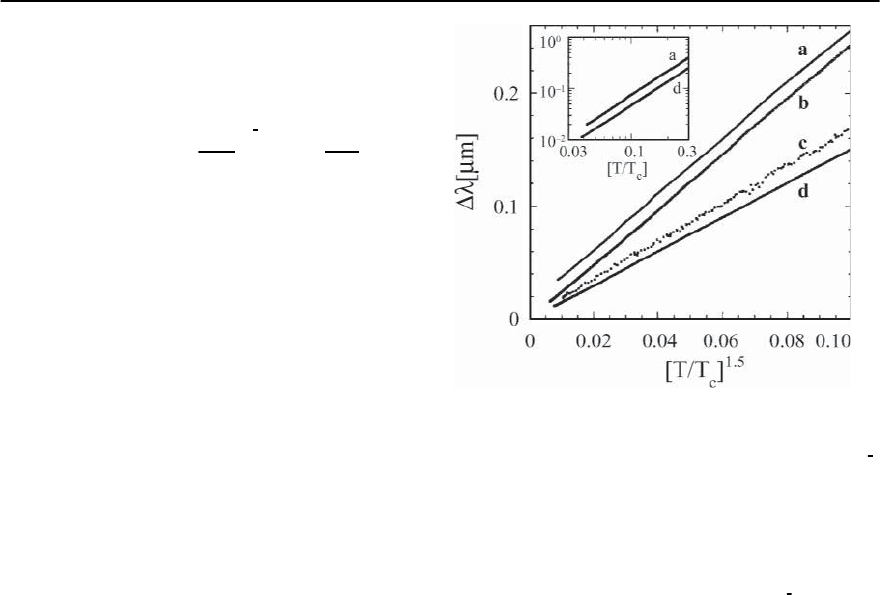
1206 M. Lang and J. M¨uller
mean-field temperature dependence of
L
around T
c
and an exponentially small variation at low temper-
atures T T
c
[348]:
L
(T) (0)
$
1+
2
k
B
T
1
2
exp
−
k
B
T
&
.
(20.17)
This holds true also for an anisotropic gap function
without nodes, where for k
B
T
min
the expo-
nential low-temperature behavior is governed by the
minimum value of the gap
min
. In contrast, an en-
ergy gap which vanishes along lines or at points at the
Fermi surface will result in a power-law dependence
of
L
(T) for T T
c
.
For the present materials the magnetic penetra-
tion depth has been determined by a variety of differ-
ent techniques including ac-susceptibility[265,349],
muon-spin relaxation [266,350], dc-magnetization
[267,268],surfaceimpedance [263,269] and a related
high-frequency technique using a tunnel diode os-
cillator [351]. The results of these studies, however,
are quite inconsistent regarding both the tempera-
ture dependence as well as the absolute values of
L
(T → 0) (see Table 20.2 in Sect. 20.4.2) and have
led to quite different conclusions as to the symmetry
of the superconducting order parameter.
Interestingly enough,these inconsistencies do not
only involve results from different experimental tech-
niques. Contradictory conclusions have been drawn
also on the basis of seemingly identical experiments
performed by different groups. This is the case for
surface impedance studies where the penetration
depth can be extracted from the complex conduc-
tivity.The latter is derived from the frequency shifts
and variations of the quality factor of the resonator
caused by the sample. While the surface impedance
studies using a microwave perturbation technique
on -(ET)
2
Cu(NCS)
2
and -(ET)
2
Cu[N(CN)
2
]Br by
Klein et al.[352] andDressel et al.[263] werefound to
be in goodagreementwith the BCS predictions,other
studies by Achkir et al. [269] on -(ET)
2
Cu(NCS)
2
revealed an in-T linear behavior at low tempera-
tures indicative of an order parameter with zeroes
on the Fermi surface. Deviations from an exponen-
tial temperature dependence of
L
(T) for the above
two -(ET)
2
X compounds havebeen observed also in
Fig. 20.45. Changes of the in-plane penetration depth
(T)of-(ET)
2
Cu[N(CN)
2
]Br [two samples (a), (b)]
and -(ET)
2
Cu(NCS)
2
[(c),(d)] plotted versus (T/T
c
)
3
2
.
The data have been offset, taken from [351]
a more recent experiment using an rf tunnel-diode
oscillator [351]. In contrast to the above measure-
ments by Achkir et al., however, their data of the in-
plane penetration depth rather follow a T
3
2
power law
(see Fig. 20.45). As has been argued by the authors,
the data would still be consistent with a quasi-linear
variation of the superfluid density as expected for
a d-wave superconductor with impurities or a small
residual gap [351]. Alternatively, the authors point
out that the exponent 3/2 may arise naturally in a
model proposed for short-coherence-length super-
conductors exhibiting a pseudogap [353].
An inconsistency exists also for SR experiments
performed by different groups. Here
L
can be de-
termined by measuring the field inhomogeneities in
the mixed state, i.e. the spatial variation of the local
induction of the vortex lattice. This technique was
first applied to -(ET)
2
Cu(NCS)
2
by Harshman et
al. [266] who could fit their data by a BCS tempera-
ture dependence.Subsequently,Le et al.[350] carried
out similar experiments on the same system as well
as on the -(ET)
2
Cu[N(CN)
2
]Br salt and found an in-
T linear variation for the in-plane penetration depth
at low temperatures
(T) ≈ 1+˛ · (T/T
c
).
A power law temperature dependence of
(T)
consistent with d-wave superconductivity has been
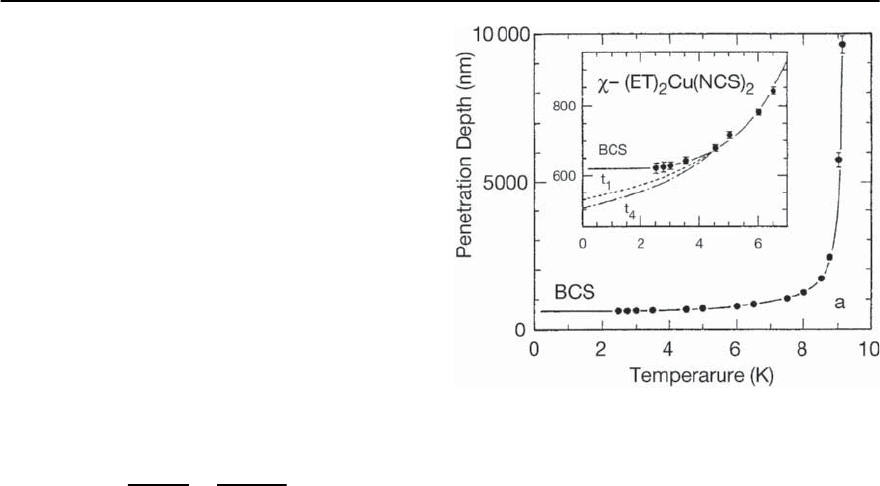
20 Organic Superconductors 1207
observed also by ac-susceptibility measurements
performed by different groups [177,265, 349]. The
latter experiments as well as the surface impedance
studies are operating at very small external mag-
netic fields (B < B
c
1
) attempting to probe the Meiss-
ner state. Possible difficulties in these experiments
that may arise from flux-pinning-related phenom-
ena near the surface of the superconductor,i.e.an in-
homogeneous superconducting state, have been dis-
cussed in [9].
An alternative way to determine the penetra-
tion depth is to make use of the reversible mixed-
state magnetization, a peculiarity of these strongly
anisotropic superconductors with short coherence
lengths.
According to the London model, the field depen-
dence of the magnetization is given by
dM
d(ln H)
=
0
32
2
2
eff
, (20.18)
where
2
eff
=
2
for B ⊥ planes and
2
eff
=
⊥
for B planes. In 3D superconductors, vortex pin-
ning usually gives rise to an inhomogeneous distri-
bution of the vortices in the mixed state and thus to
an irreversible behavior of the magnetization upon
increasing and decreasing the field. This may cause
substantial uncertaintiesin determining the penetra-
tion depth from magnetizationdata.On the contrary,
for quasi-2D superconductors with short coherence
length the magnetization is entirely reversible over
an extended field range,i.e.B
c
1
< B
irr
< B < B
c
2
with
B
irr
being the temperature-dependent irreversibility
line (see Sect. 20.4.3). For -(ET)
2
Cu(NCS)
2
and -
(ET)
2
Cu[N(CN)
2
]Br a reversible magnetization has
been observed over an extended range in the B–T
plane which thus allows for a precise determination
of the in-plane penetration depth [267,268].The in-
plane penetration depths
(T) were determined,
see Fig. 20.46, from the slopes dM/d(ln H)ofthe
isotherms taken at different temperatures and using
(20.18).The solidline represents a BCS fit [348] to the
data. For both systems, the data reveal only a weak
variation with temperature at low T consistent with
an exponential temperature dependence as expected
for a finite gap.
Fig. 20.46. In-plane penetration depth for single crys-
talline -(ET)
2
Cu(NCS)
2
.Thesolid line represents a BCS
fit.The model calculations labelled t
1
and t
4
represent those
anisotropic states proposed by Hasegawa et al. [354] and
used by Le et al. to explain their SR data [350] which
have the weakest and strongest T dependences, respec-
tively, taken from [267]
Specific Heat
The above variety of contradictory results on the
magnetic penetration depth indicate an extraordi-
narily high sensitivity of this quantity to extrinsic
effects such as disorder or pinning-related phenom-
ena. As a possible source, we mention the disorder
associated with the glass transition of the ethylene
endgroups, see Sect. 20.3.4 and [177].
A quantity which is less sensitive to the above
problems but can still provide fundamental infor-
mation on the gap structure is the specific heat. In
case this integral thermodynamic quantity were to
find a low temperature electronic quasiparticle con-
tribution, C
es
, that varies exponentially weakly with
the temperature, the existence of gap zeroes on the
Fermi surface could be definitely ruled out. On the
other hand, the observation of a non-exponential
temperature dependence does not necessarily prove
the existence of gap zeroes as this result might orig-
inate in extraneous contributions such as impurity
phases, normal-conducting regions or pair-breaking
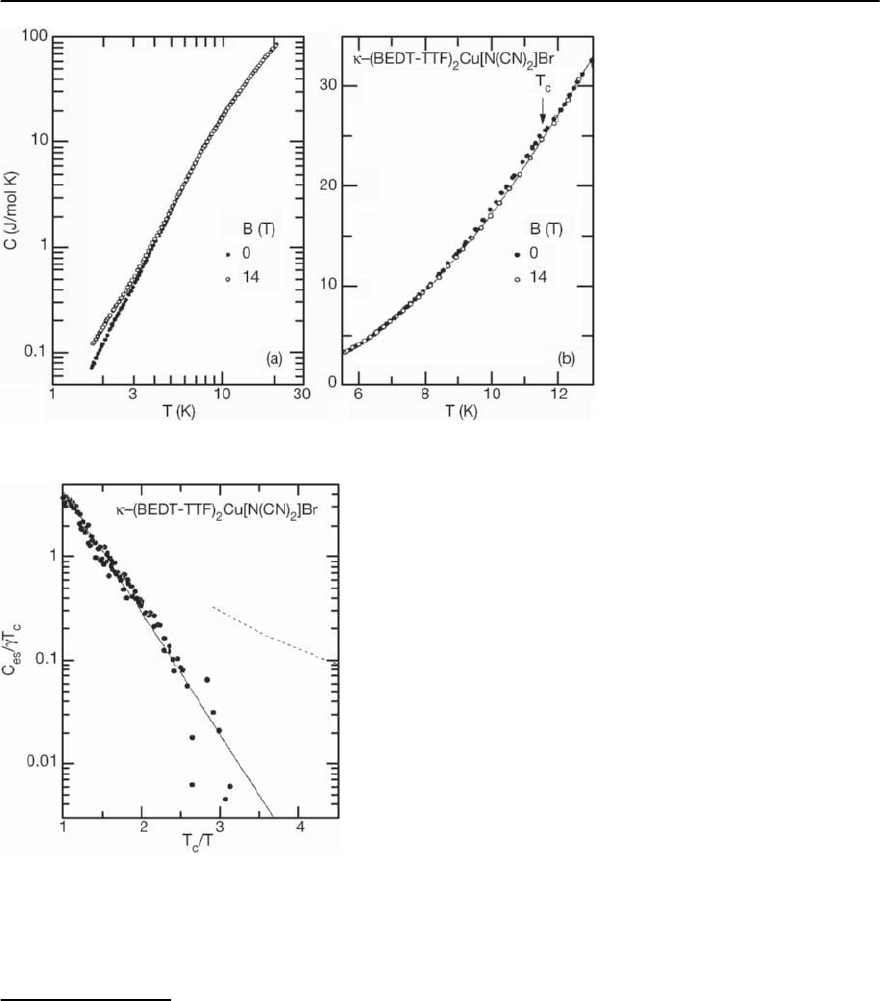
1208 M. Lang and J. M¨uller
Fig. 20.47. Temperature depen-
dence of the specific heat of
-(ET)
2
Cu[N(CN)
2
]Br in the su-
perconducting (B = 0) and normal
state (B =14T)overanextended
temperature range (left panel)
and in the vicinity of T
c
=11.5K
(right panel). The solid line is a
polynomial fit to the 14 T data,
taken from [233]
Fig. 20.48.A semi-logarithmic plot of C
es
/( T
c
)vsT
c
/T as
determinedfrom thedata shown in Fig.20.47.Thesolid line
indicates the exponential variation of C
es
.Thedashed line
corresponds to C
es
as determined by Nakazawa et al.[356]
(see text and footnote 27), taken from [233]
effects. First specific heat measurements were fo-
cussing on the determination of the discontinuity
at T
c
which provides information on the coupling
strength.Fromthe results of Andraka et al.[355] and
Graebner et al. [270] on -(ET)
2
Cu(NCS)
2
yielding
aratioofC/ T
c
> 2 a strong-coupling behavior
has been inferred for this salt. In a series of sub-
sequent experiments, the temperature dependence
of the electronic contribution,C
es
, at lower temper-
atures was at the focus of the investigations. From
experiments on -(ET)
2
Cu[N(CN)
2
]Br Nakazawa et
al. [356] reported a quadratic temperature depen-
dence of C
es
at low temperatures, which was taken
as an indication for line nodes in the gap. However,
recent high-resolution specific heat measurements
on the same compound revealed an exponentially
weak low-T electronic contribution to the specific
heat implying a finite energy gap [233]. Moreover it
has been shown in the latter study that the T
2
de-
pendence in the C
es
data by Nakazawa et al. [356]
most likely originates in their incorrect determina-
tion of the phonon background
26
. Figures 20.47 and
26
In [356] the lattice specific heat of -(ET)
2
Cu[N(CN)
2
]Br was estimated by measuring a second, deuterated sample
after quench cooling to suppress superconductivity. The data analysis in [356] is based on the assumption that by this
procedure the lattice specific heat remains unaffected and is identical to that of the hydrogenated superconducting
compound. In [233] it has been shown, however, that the so-derived phonon background differs substantially from
that determined in an overcritical field. The reason for this might be related to the glass-like transition at T
g
observed
in this system [99], see Sect. 20.3.4.
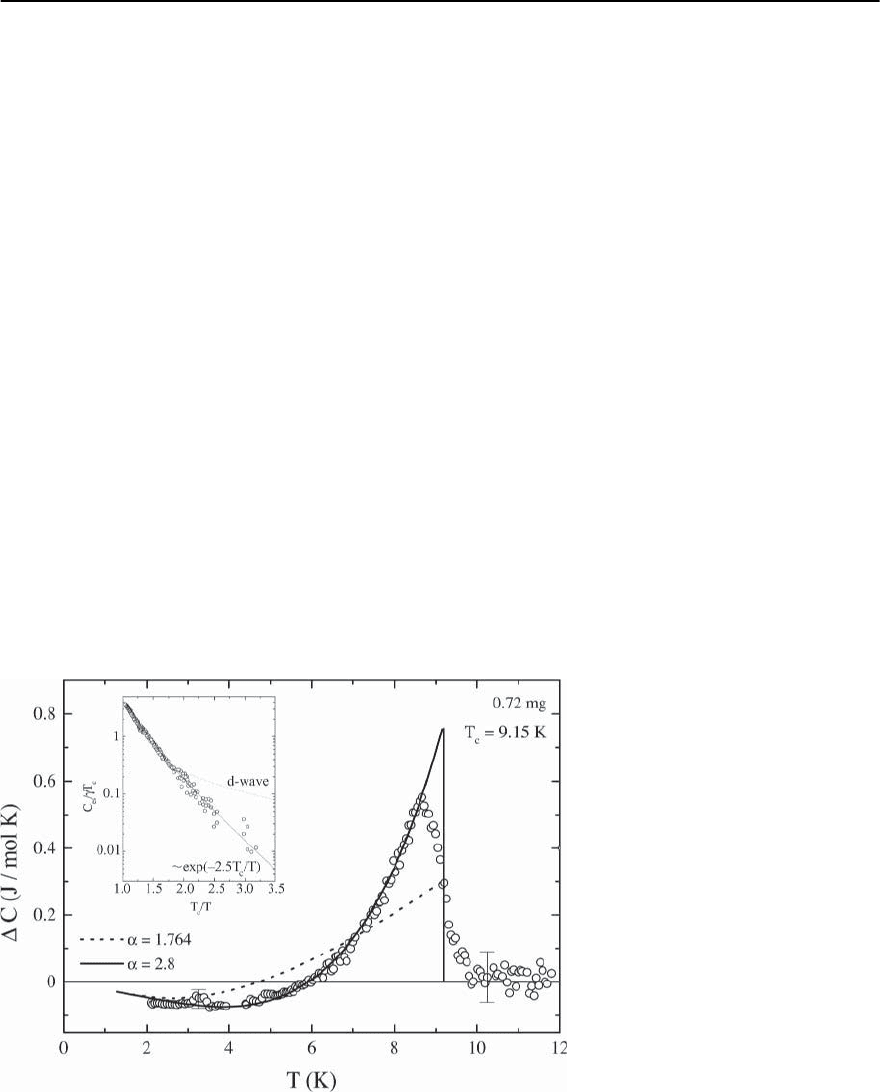
20 Organic Superconductors 1209
20.48 show the results of specific heat measurements
performed by Elsinger et al. [233]. The phonon con-
tribution, which predominates the specific heat near
T
c
has been determined from measurements in an
overcritical field. This standard procedure is valid
as long as there are no magnetic contributions to the
specific heat whichmight change with the field.From
the absence of any measurable field dependence in
the data above T
c
this assumption appears justified.
Figure 20.48 shows the exponential decrease of C
es
with decreasing temperatures.The lack of a finite C
es
for T → 0 rules out the existence of zeroes in the
energy gap.
A similar behavior has been observed also for -
(ET)
2
Cu(NCS)
2
[49,50]. Figure 20.49 shows the dif-
ference C(T)=C(T, B =0)−C(T, B =8T> B
c
2
)
used to analyze the specific heat data. The advan-
tage of using this quantity means that the unknown
phonon contributiondrops out.As Fig.20.49 demon-
strates, C(T) deviates markedly from the weak-
coupling BCS behavior in both the jump height at T
c
as well as the overall temperature dependence. How-
ever, as was found also for -(ET)
2
Cu[N(CN)
2
]Br
[233], a much better description of the data is ob-
tained by using the semi-empirical extension of the
Fig. 20.49. Specific heat difference C =
C(0 T) − C(8 T) of a -(ET)
2
Cu(NCS)
2
single crystal of m = 0.72 mg (main
panel). The dotted and solid thick lines
represent the BCS curves for weak and
strong coupling, respectively. The in-
set shows the quasiparticle contribu-
tion to the specific heat in the super-
conductingstateasC
es
/ T
c
vsT
c
/T ina
semi-logarithmic representation. Here
the solid line represents the strong-
coupling BCS behavior while the dotted
line indicates a T
2
behavior as expected
for a d-wave order parameter [358],
taken from [49,187]
BCS formalism to strong-coupling superconductors;
the so-called ˛-model [357].It contains a single free
parameter ˛ ≡
0
/k
B
T
c
which scales the BCS energy
gap (T)=(˛/˛
BCS
) ·
BCS
(T)with˛
BCS
=1.764.As
Fig. 20.49 clearly demonstrates, the strong-coupling
BCS model with ˛ =2.8 ± 0.1providesanexcel-
lent description of the data over the entire temper-
ature range investigated [49]. Similar to what has
been found for -(ET)
2
Cu[N(CN)
2
]Br (Fig. 20.48),
the data for -(ET)
2
Cu(NCS)
2
(inset of Fig. 20.49)
are fully consistent with an exponentially small C
es
at low temperatures, i.e. an energy gap without ze-
roes at the Fermi surface. The same behavior has
been previously observed for other (ET)
2
Xsuper-
conductors [50,359, 360]. The above findings of an
exponentially weak specific heat at low temperatures
are clearly incompatible with the existence of gap ze-
roes as claimed by various of the above mentioned
experiments. It has to be shown by future studies
whether or not this controversy can be removed by
taking properly into account the influence of mag-
netic fields even when applied parallel to the planes
and other extraneous effects such as the cooling-
rate-dependent disorder associated with the ethylene
groups.
